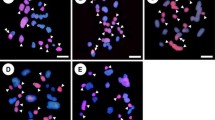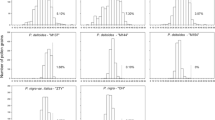Summary
Chromosome association at MI of PMCs in hybrids of I. laevigata x I. ensata was examined and compared with that of parental species. The mean chromosome association per cell in the parental species was 0.02I+11.99II for I. ensata (‘Kachô’, 2n=24), 0.11I+15.94II and 0.15I+15.92II for I. laevigata (‘Yukidôrô’ and wild type, 2n=32), respectively. On the other hand, the mean chromosome association per cell in the hybrids (2n=28) was 20.22I+3.88II+0.0046IV for ‘Yukidôrô’ × ‘Kachô’ and 20.92I+3.54II for wild type × ‘Kachô’. Thus, the hybrids indicated a low homology between I. ensata and I. laevigata, and did not exhibit pollen and seed fertility. The utility of the hybrids was discussed.
Similar content being viewed by others
References
Avishai M. & D. Zohary, 1977. Chromosome in the Oncocyclus irises. Bot. Gaz. 138 502–511.
Avishai M. & D. Zohary, 1980. Genetic affinities among the Oncocyclus irises. Bot. Gaz. 141: 107–115.
Lawrence G. H. M. & L. F. Randolph, 1959. The classification of irises. Garden irises. The Cayuga Press Inc., New York, p. 133–160.
Sakurai O. & K. Tomino, 1969. Studies of Iris breeding. I. Crossing ability between Iris species involving I. ensata Thunb, var. ensata. Japan. J. Breed. 19 (Suppl. 1): 151–152 (in Japanese).
Tomino K., 1963. Studies on the genus Iris in Japan especially cytotaxonomy of the genus and breeding of Iris ensata Thunberg. Bull. Lib. Art. Dep. Mie Univ. 28: 1–59 (in Japanese with English summary).
Tomino K. & O. Sakurai, 1972. Cross between Iris pseudacorus L. and I. ensata Thunb. Bull. Fac. Edu. Mie Univ. 23: 17–26 (in Japanese).
Yabuya T. & H. Yamagata, 1975. Breeding of the interspecific hybrids in Iris. I. F1 plants obtained by embryo culture in the cross I. laevigata Fisch. × I. ensata Thunb. Japan. J. Breed. 25 (Suppl. 2): 82–83 (in Japanese).
Yabuya T. & H. Yamagata, 1978. Embryological and cytological studies on seed development after reciprocal crosses between Iris sanguinea Hornem. and I. laevigata Fisch. Japan J. Breed. 28: 211–224.
Yabuya T. & H. Yamagata, 1980a. Pollen-tube growth, fertilization and ovule development in reciprocal crosses between Iris ensata Thunb. and I. pseudacorus L. Japan J. Breed. 30 (Suppl. 1): 168–169 (in Japanese).
Yabuya T. & H. Yamagata, 1980b. Elucidation of seed failure and breeding of F1 hybrid in reciprocal crosses between Iris ensata Thunb. and I. laevigata Fisch. Japan J. Breed. 30: 139–150.
Yabuya T., T. Adachi & T. Nagatomo, 1983. Production of F1 hybrids in Iris laevigata Fisch. × I. ensata Thunb. and their traits. Agr. Bull. Miyazaki Univ. 30: 15–21; in Japanese with English summary).
Author information
Authors and Affiliations
Rights and permissions
About this article
Cite this article
Yabuya, T. Chromosome association and fertility in hybrids of Iris laevigata Fisch. x I. ensata Thunb. . Euphytica 33, 369–376 (1984). https://doi.org/10.1007/BF00021134
Received:
Issue Date:
DOI: https://doi.org/10.1007/BF00021134




